Enhancement of multiatom non-classical correlations and quantum state transfer in atom–cavity–fiber system*
2021-01-21QiLiangHe贺启亮JianSun孙剑XiaoShuSong宋晓书andYongJunXiao肖勇军
Qi-Liang He(贺启亮), Jian Sun(孙剑), Xiao-Shu Song(宋晓书), and Yong-Jun Xiao(肖勇军)
School of Physics and Electronics,Guizhou Normal University,Guiyang 550001,China
Keywords: atom–cavity–fiber system,quantum state transfer,parity kicks pulses
1. Introduction
The superposition principle is one of the most striking features of quantum mechanics, which leads to the quantum entanglement,that cannot exist in classical physics. Quantum entanglement,introduced by Einstein,Podolsky,and Rosen in 1935,[1]is a fundamental and fascinating quantum effect and plays a key role in quantum information processing.[2–4]However,some researches denote that entanglement is not the only type of quantum correlation useful for quantum information processing and there exists another non-classical correlation which is more general and more fundamental than quantum entanglement. Such a correlation, is called quantum discord by Ollivier and Zurek[5]with a definition based on the difference between the quantum mutual information and the classical correlation and is nonzero even for separate mixed states.It has been demonstrated both theoretically and experimentally that the quantum states with nonzero quantum discord but without entanglement,can be responsible for the achievement of quantum speedup in certain computational tasks.[6–8]In addition, much recent attention has been paid to investigate the quantum discord in a variety of systems,such as spin chain,[9–11]quantum dot,[12]NMR,[13]and accelerated qubit systems.[14]
On the other hand, the cavity QED (quantum electrodynamics) system is regarded as an alternative promising candidate for non-classical correlation engineering and quantum information processing.[15–17]In particular, during the past years,much attention has been paid to the possibility of quantum information processing realized via the atom–cavity–fiber systems,which can be used to implement quantum communication and engineer quantum logical gates.[18–34]For example,Bose et al.proposed a scheme to realize the effective quantum gates between two atoms in distant cavities coupled by optical fibers.[19]Yang et al.presented two schemes for realizing quantum logic gates between two atoms trapped in two separate cavities connected by an optical fiber.[20,21]Shen et al.considered two dissipative schemes for preparing the steadystate entanglement of two atoms trapped in distant cavities coupled by an optical fiber.[22,23]In Refs. [24,25], Wu et al.investigated two schemes for realizing and engineering the qutrit–qutrit maximal entanglement of two atoms held in separate cavities coupled by an optical resonator. In Ref. [26],Yang et al. explored the the deterministic coherent manipulation of two atomic qutrits trapped in separate cavities coupled through an optical fiber. Ye et al.studied the possibility of generating effective three-dimensional entanglement of two distant atoms separately trapped in two optical cavities connected by an optical fiber.[30]Zhong proposed a scheme for fast quantum-information transfer in a two-dimensional quantum network.[31]Furthermore, it has been also demonstrated both theoretically and experimentally that a quantum network in which the transfer of an atomic quantum state and the creation of entanglement between two nodes can be realized by the atom–cavity–fiber system.[32]
In the present paper, we will investigate the influence of the parity kicks pulses on the multiatom non-classical correlation and entangled state transfer of a system consisting of two identical subsystems. Each subsystem contains multiple two-level atoms,trapped in two remote cavities connected by an optical fiber. It is found that the amount of non-classical correlation and the fidelity of entangled state transfer can be enhanced by applying a train of parity kicks pulses. In particular,with decrease of the time intervals between two consecutive pulses,the optimal non-classical correlations transfer and entangled state transfer can be achieved. Furthermore,we will explore also the exchange of the quantum information flows of this system by a witness of trace distance. It is shown that the exchange of the quantum information between the atoms and the fields can be switched off via the parity kicks pulses when the optimal quantum state transfer is accomplished.
2. Dynamical evolution of the model with parity kicks pulses
We now investigate a system (as shown in Fig. 1) consisting of two identical subsystems,[35]which include multiple two-level atoms trapped in two distant single-mode optical cavities coupled by an optical fiber,where the system is driven by the parity kicks pulses. Here,we consider that the two subsystems are independent and the atoms in the same cavity are separated enough, which means the atoms have no direct interaction with the other one. Under the case of the short fiber limit, the Hamiltonian of the whole system with parity kicks pulses can be written as follows:[35,36]

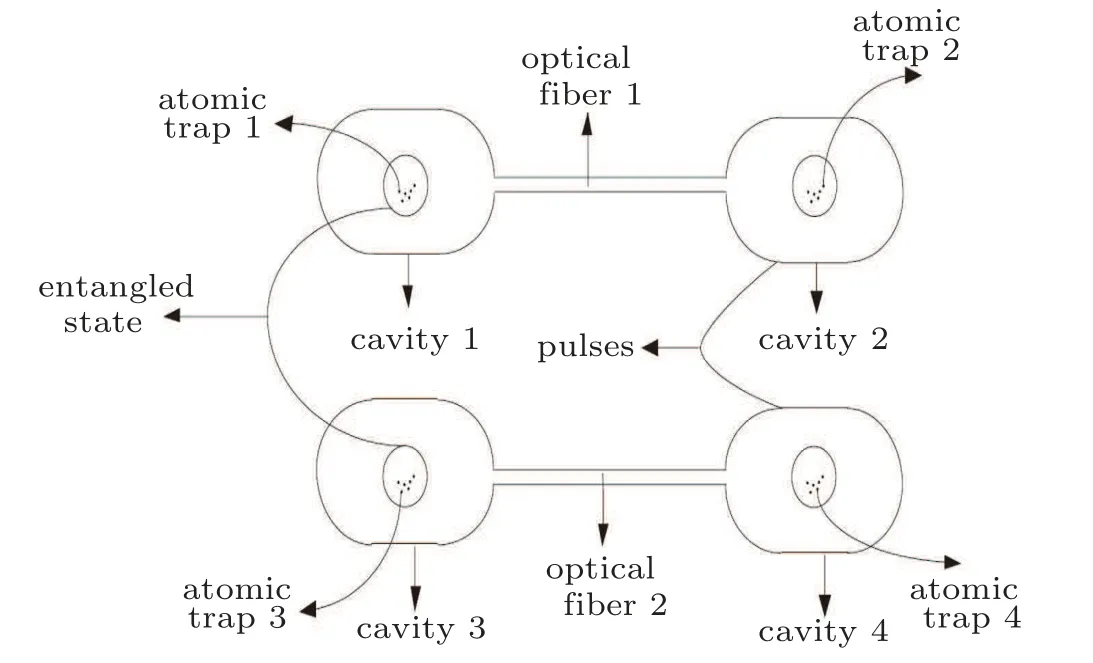
Fig. 1. The schematic diagram of the system investigated in the current paper.
Furthermore,in Eq.(1),HPis the Hamiltonian of the parity kicks pulses and can be described as[36]


where θ(t)is the usual step function,T is the time interval between two consecutive pulses,the pulse height V0and the pulse width τ satisfy the condition V0τ=π,which means that we consider the π pulse only. For the case that the pulse is strong enough,i.e., the duration τ →0, the time evolution operator with the pulse can be derived as

Next, we begin to calculate the dynamical evolution of this system with parity kicks pulses. First, we assume that the initial state of the total system is prepared in the following form

where, α and β are complex numbers with the condition|α|2+|β|2=1; the state |0,N〉 represents that N atoms are all in the ground state as the computational basis|0〉, and the state |1,N-1〉 represents that N-1 atoms are in the ground state and one atom in the excited state as the computational basis|1〉.
By making use of the Eqs.(6)and(8),it is not difficult to figure out the state of the whole system at time t is

with
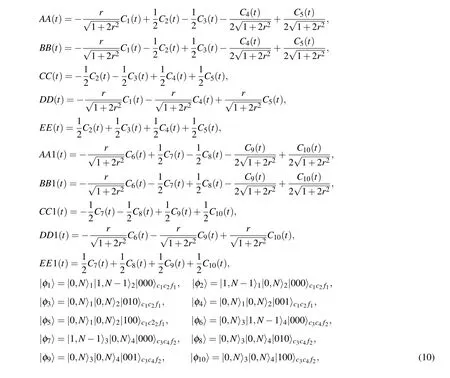
where


From Eq.(10),we can find the coefficients

By making use of Eq. (9), in the standard product basis {|1,N -1〉1|1,N -1〉3,|1,N -1〉1|0,N〉3,|0,N〉1|1,N -1〉3,|0,N〉1|0,N〉3},it is not difficult to obtain the reduced den-

with the following explicit element expressions for the above matrix:
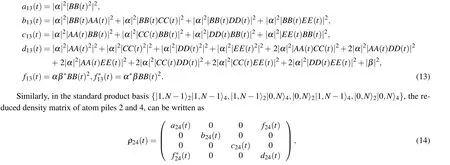
where

3. Transfer of non-classical correlations with parity kicks pulses
In this section,we investigate the transfer of non-classical correlation(quantum entanglement and quantum discord)with parity kicks pulses. To quantity the quantum entanglement,we adopt concurrence.[37]For a two-qubit system,the concurrence can be defined as follows:

with
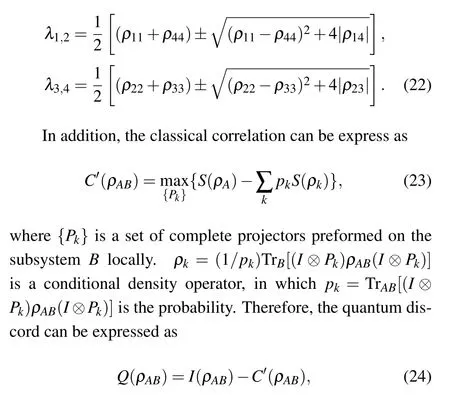
where the difference between the total correlation and the classical correlations is used to quantify quantum discord.
According to Eq. (18) and the method introduced in Ref.[39],the analytical expression of the quantum discord of the two-qubit system can be obtained. Here,we do not list the concrete expression of the quantum discord because it is rather long and complex.

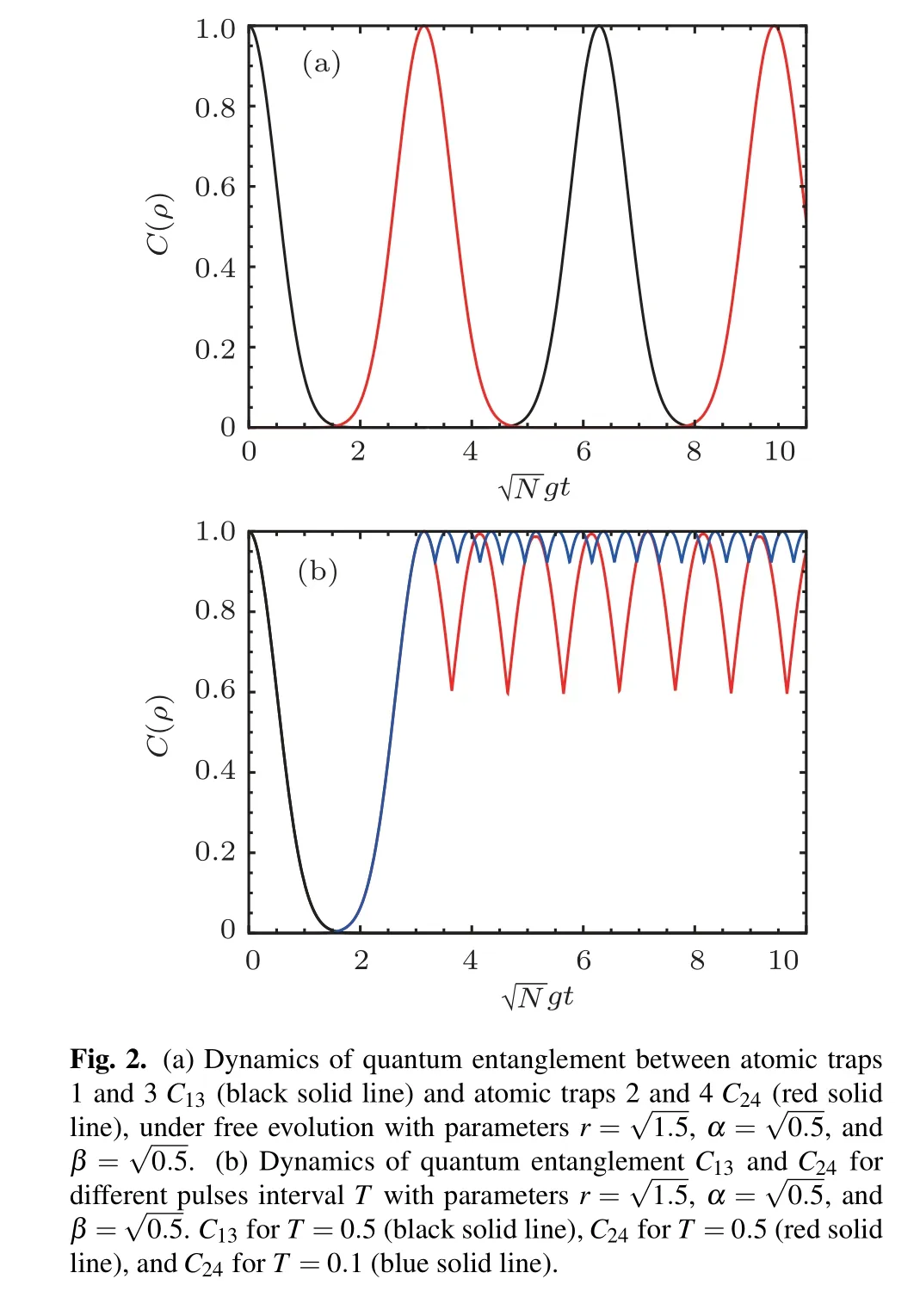
The influence of the parity kicks pulses on the nonclassical correlations transfer between atomic traps 1, 3 and atomic traps 2, 4 are displayed for different pulses interval T in panels(b)of Figs.2 and 3. We find that the amount of nonclassical correlations of atomic traps 2, 4 (C24and Q24) can be increased by the pulses, and the nonclassical correlations can recover to their maximum values (i.e. close to 1 ) at the points t2N. Furthermore,it is obvious that the variation period of nonclassical correlations equals to 2T and the amplitude of nonclassical correlations of atomic traps 2,4(C24and Q24)is smaller for pulses with shorter time intervals T. This means that the parity kicks pulses can be used to improve the effect of transmission of the non-classical correlations and control the duration time of the completion of non-classical correlations transfer to be longer. That is to say, the parity kicks pulses can switch off the interaction between the atoms and the fields once the non-classical correlations transfer is achieved.
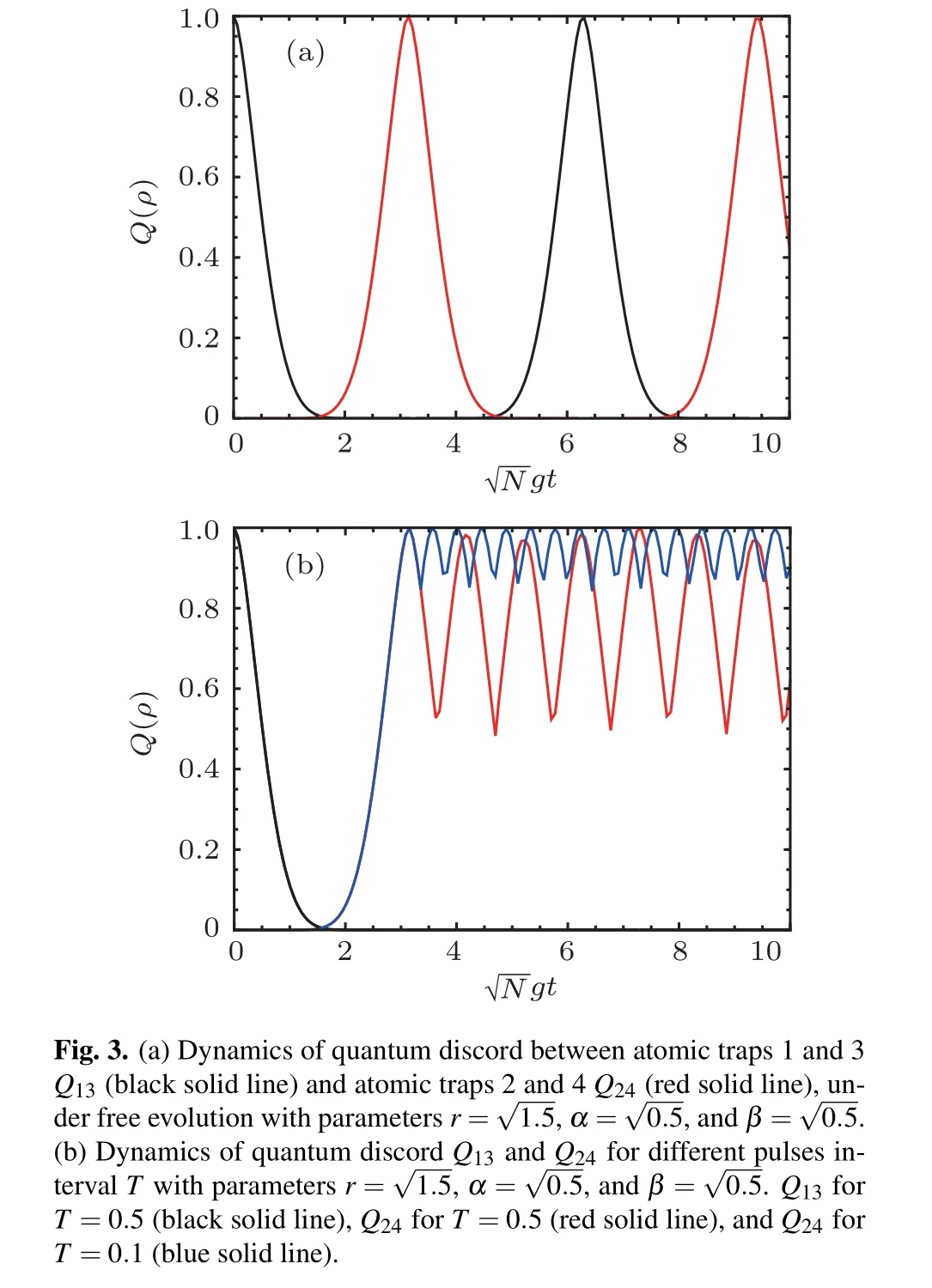
4. Fidelity for the quantum entangled state transfer with parity kicks pulses
In this section,we survey entangled state transfer between two atom traps with parity kicks pulses.To quantify the degree of entangled state transfer, we adopt the fidelity, which is introduced by Nielsen and Paulina Marian[40,41]
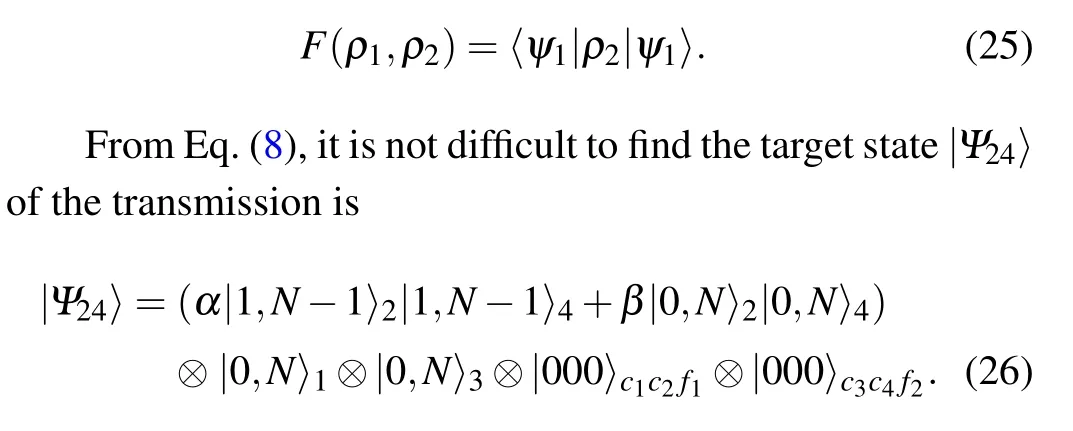
According to Eqs. (8), (25), and (26), we can derive the fidelity F(t)of the entangled state transfer from atomic traps 1,3 to atomic traps 2,4 as


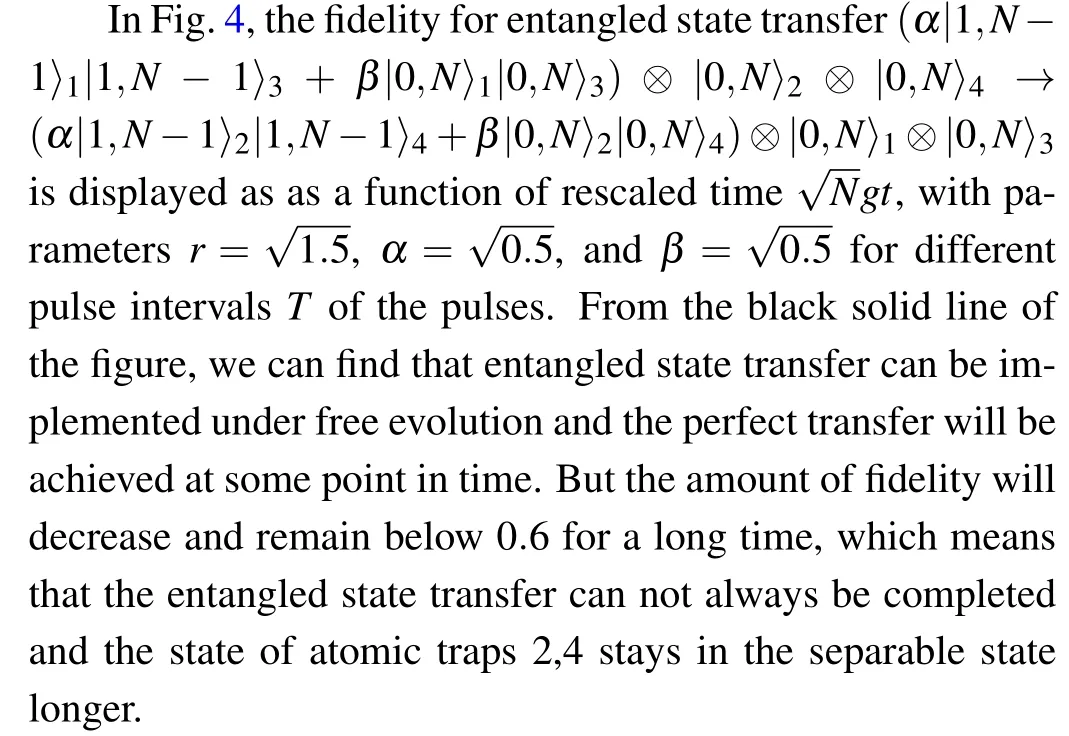
Comparing the red dashed line with the black solid line of Fig.4,it is obvious that the amount of fidelity can be enhanced by the pulses,and the fidelity can recover to maximum values(i.e. close to 1 ) at the points t2N. Furthermore, it is clearly found that the variation period of fidelity equals to 2T and the amplitude is smaller for pulses with shorter time intervals T.This means that the quality of transmission of the entangled state can be improved and the longer time of the the target state|Ψ24〉of atomic traps 2,4 can be maintained by applying the parity kicks pulses.
In order to further understand why the fidelity for entangled state transfer can be increased by the parity kicks pulses,we investigate the influence of the parity kicks pulses on the exchange information between the atoms and the fields by employing the trace distance. The trace distance, introduced by Breuer, Laine, and Piilo,[42]is used to measure the behavior of non-Markovian process and explore the transfer of quantum information in a quantum system.[43,44]Some results have been identified by several experiments.[45,46]As a measure of state distinguishability between two quantum states ρ1and ρ2,the trace distance can be defined as[42]By making use of Eqs. (8), (14), and (28), the trace of atomic traps 2,4 can be derived as

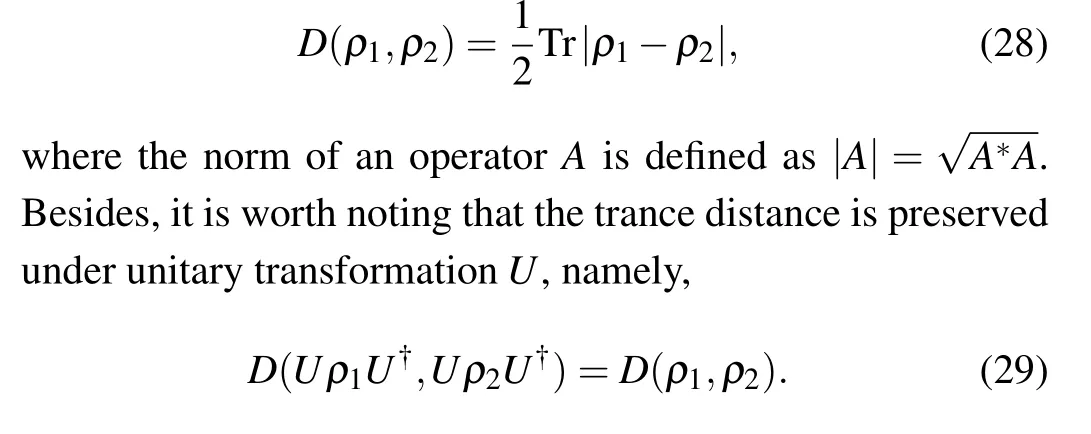
where AA(t), BB(t),CC(t), DD(t), and EE(t) are defined in Eq.(10).

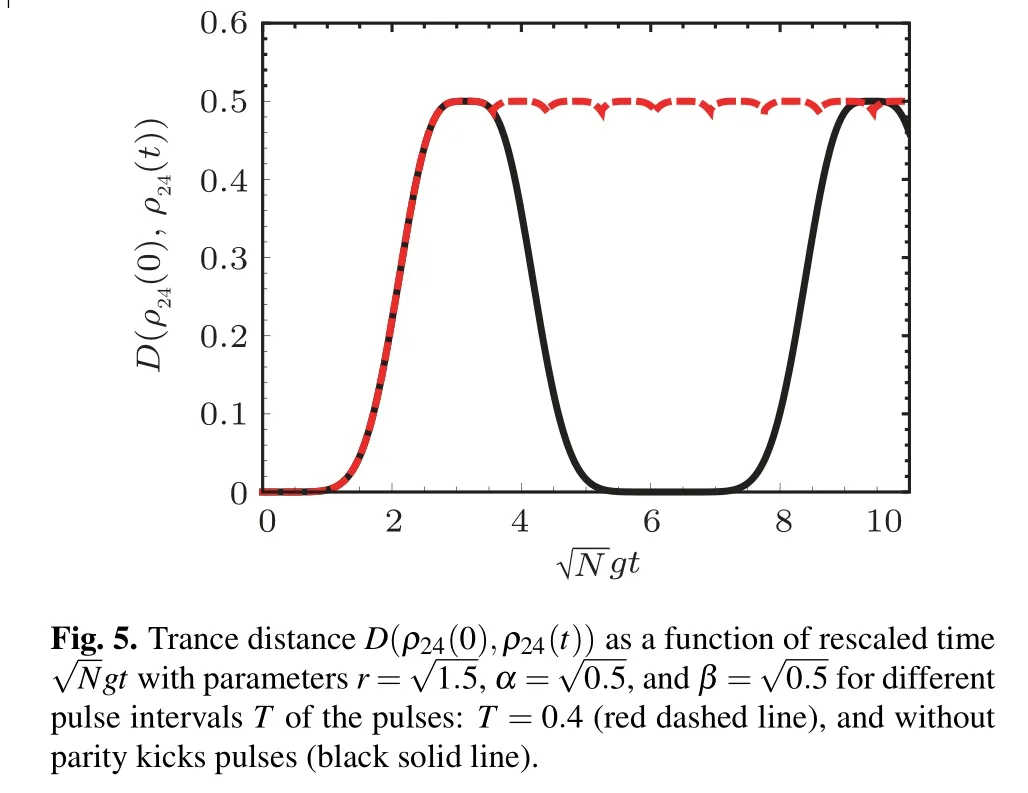
Comparing the red dashed line with the black solid line in Fig. 5, we can see clearly that the trace distance can be enhanced by applying the parity kicks pulses, which means that the parity kicks pulses can suppress the interaction between the atoms and the fields, and prevent the information contained in the atomic traps 2, 4 from leaking to the other subsystems, namely, the parity kicks pulses can lead to the decrease of the information flowed back. The physical explanation of this phenomenon is that the parity kicks pulses can protect quantum information between atomic traps 2, 4 and prevent the quantum information from flowing into the fields or other bipartite subsystems. This result indicates that the interaction between the atoms and the fields can be switched off and the target state of the transmission(i.e.,|Ψ24〉)can be protected by applying the parity kicks pulses.
5. Conclusions
In the present paper, we investigated multiatom nonclassical correlations and entangled state transfer of a system consisting of two identical subsystems (as shown in Fig. 1).Each subsystem contains multiple two-level atoms,which are trapped in two distant single-mode optical cavities that are connected by two optical fibers,where the subsystem is driven by parity kicks pulses. It is shown that the amount of nonclassical correlations of atomic traps 2, 4 (C24and Q24) and the fidelity of the target state of the transmission can be effectively enhanced with the help of the parity kicks pulses, and the increased amplitude is larger for shorter time intervals of the control pulses. Particularly, the non-classical correlations and the fidelity can recover to their maximum values(i.e.close to 1)at the points t2Nand the amplitude of non-classical correlations and the fidelity is smaller for the pulses with shorter time intervals T, which demonstrate that the nearly perfect non-classical correlations transfer and entangled state transfer can be realized, if the time interval of parity kicks pulses to be infinitely small, namely, T →0. Furthermore, in order to further understand why the fidelity for entangled state transfer can be increased by the parity kicks pulses, we also study the influence of parity kicks pulses on the information exchange between the atoms and the fields by employing the trace distance. It is shown that trace distance of atomic traps 2,4 can be enhanced by applying the parity kicks pulses,which indicate that the pulses can protect quantum information between atomic traps 2, 4 and control the quantum information to flow back from the other subsystems to the atomic traps 2,4 immediately,that is,the parity kicks pulses can be used to protected the transfer of the non-classical correlation and the quantum state. This result implies that the interaction between the atoms and the fields can be switched off and the target state of the perfect transmission(i.e.,|Ψ24〉)can be realized by applying the parity kicks pulses. The method adopted here may provide a way to improve the manipulation of quantum logic gates[20,21]and the implementation of quantum information tasks[24–26]in atom–cavity–fiber system. Furthermore, it can even be used in the open coupled-cavity QED system to polish up the performance of quantum information processing.[22,23]
杂志排行
Chinese Physics B的其它文章
- Two-dimensional finite element mesh generation algorithm for electromagnetic field calculation*
- Stable water droplets on composite structures formed by embedded water into fully hydroxylated β-cristobalite silica*
- Surface active agents stabilize nanodroplets and enhance haze formation*
- Synchronization mechanism of clapping rhythms in mutual interacting individuals*
- Theoretical study of the hyperfine interaction constants,Land´e g-factors,and electric quadrupole moments for the low-lying states of the 61Niq+(q=11,12,14,and 15)ions*
- Ultrafast photoionization of ions and molecules by orthogonally polarized intense laser pulses: Effects of the time delay*
